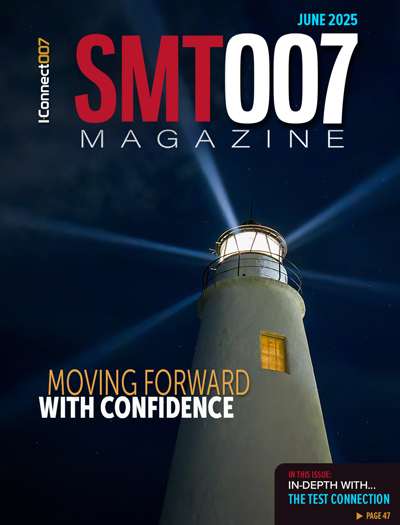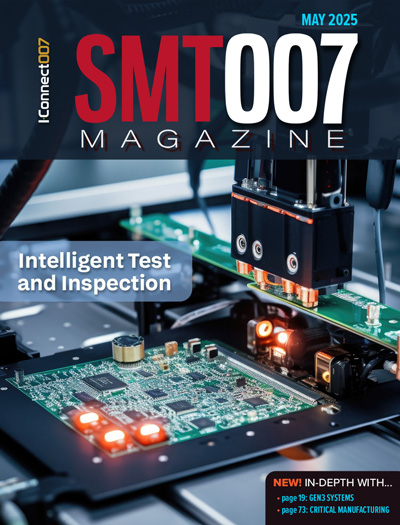-

-
News
News Highlights
- Books
Featured Books
- smt007 Magazine
Latest Issues
Current Issue
What's Your Sweet Spot?
Are you in a niche that’s growing or shrinking? Is it time to reassess and refocus? We spotlight companies thriving by redefining or reinforcing their niche. What are their insights?

Moving Forward With Confidence
In this issue, we focus on sales and quoting, workforce training, new IPC leadership in the U.S. and Canada, the effects of tariffs, CFX standards, and much more—all designed to provide perspective as you move through the cloud bank of today's shifting economic market.

Intelligent Test and Inspection
Are you ready to explore the cutting-edge advancements shaping the electronics manufacturing industry? The May 2025 issue of SMT007 Magazine is packed with insights, innovations, and expert perspectives that you won’t want to miss.
- Articles
- Columns
- Links
- Media kit
||| MENU - smt007 Magazine
Indium Joins Virginia Tech Center for Power Electronics Systems Industry Consortium
June 3, 2025 | Indium CorporationEstimated reading time: Less than a minute
Indium Corporation®, a leading materials refiner, smelter, manufacturer, and supplier to the global electronics, semiconductor, thin-film, and thermal management markets, has joined Virginia Tech’s Center for Power Electronics Systems (CPES), an industry consortium that supports power electronics initiatives to reduce energy use while growing capability.
CPES is dedicated to improving electrical power processing and distribution that impact systems of all sizes, from battery-operated electronics and vehicles to regional and national electrical distribution systems. The organization has a worldwide reputation for its research advances, its work with industry to improve the entire field, and its many talented graduates.
With a specific focus on power device packaging, Indium Corporation continues to advance its portfolio of die-attach, package-attach, and thermal interface materials (TIMs) solutions that are custom-engineered to satisfy the mission profile demands for power electronics applications.
“Advancing materials technology is a key enabler to realize our design goals for power electronics,” said Ryan Mayberry, Senior Application Development Engineer at Indium Corporation. “Through collaboration with CPES, Indium Corporation will leverage innovations in materials science and align research and development initiatives to address future power device requirements.”
Suggested Items
Epirus Receives $43.5 Million Contract from U.S. Army for IFPC-HPM Generation II Systems
07/18/2025 | PRNewswireEpirus announced a $43,551,060 contract from the U.S. Army's Rapid Capabilities and Critical Technologies Office (RCCTO).
Eaton Signs Agreement to Acquire Resilient Power Systems
07/16/2025 | BUSINESS WIREIntelligent power management company Eaton announced it has signed an agreement to acquire Resilient Power Systems Inc., a leading North American developer and manufacturer of innovative energy solutions, including solid-state transformer-based technology.
Beyond Design: Refining Design Constraints
07/17/2025 | Barry Olney -- Column: Beyond DesignBefore starting any project, it is crucial to develop a thorough plan that encompasses all essential requirements. This ensures that the final product not only aligns with the design concept but is also manufacturable, reliable, and meets performance expectations. High-speed PCB design requires us to not only push technological boundaries but also consider various factors related to higher frequencies, faster transition times, and increased bandwidths during the design process.
Copper Price Surge Raises Alarms for Electronics
07/15/2025 | Global Electronics Association Advocacy and Government Relations TeamThe copper market is experiencing major turbulence in the wake of U.S. President Donald Trump’s announcement of a 50% tariff on imported copper effective Aug. 1. Recent news reports, including from the New York Times, sent U.S. copper futures soaring to record highs, climbing nearly 13% in a single day as manufacturers braced for supply shocks and surging costs.
Global Citizenship: The Global Push for Digital Inclusion
07/16/2025 | Tom Yang -- Column: Global CitizenshipIt can be too easy to take the technology at our fingertips for granted: high-speed internet, cloud-based collaboration, and instant video calls across continents. Yet, for billions of people, access to these digital tools is a distant dream. As a global community, we must ensure that technology is available to all. Here is how technology is bridging physical, economic, and educational gaps in underserved regions and profoundly reshaping lives.


